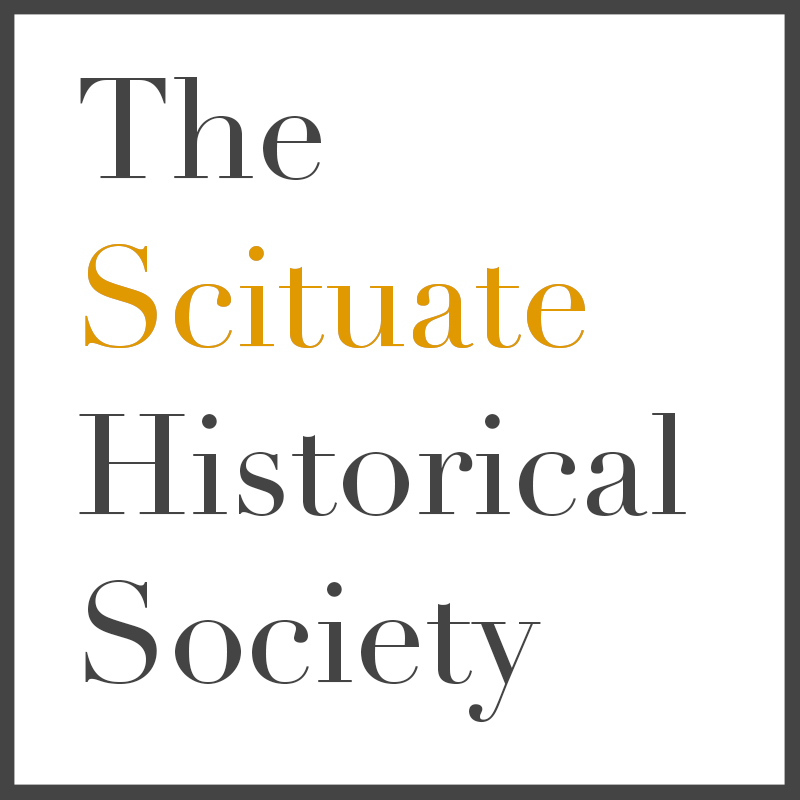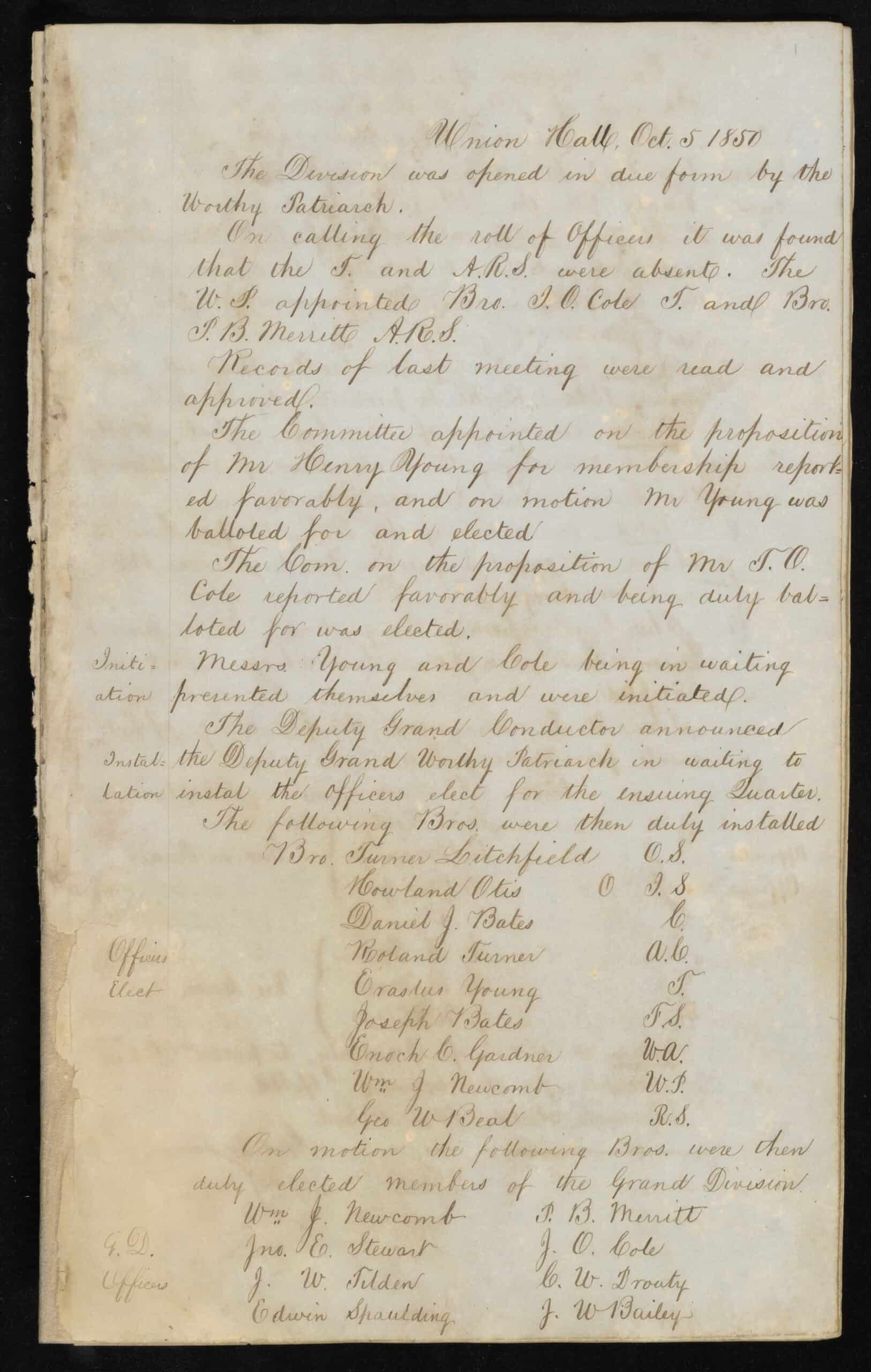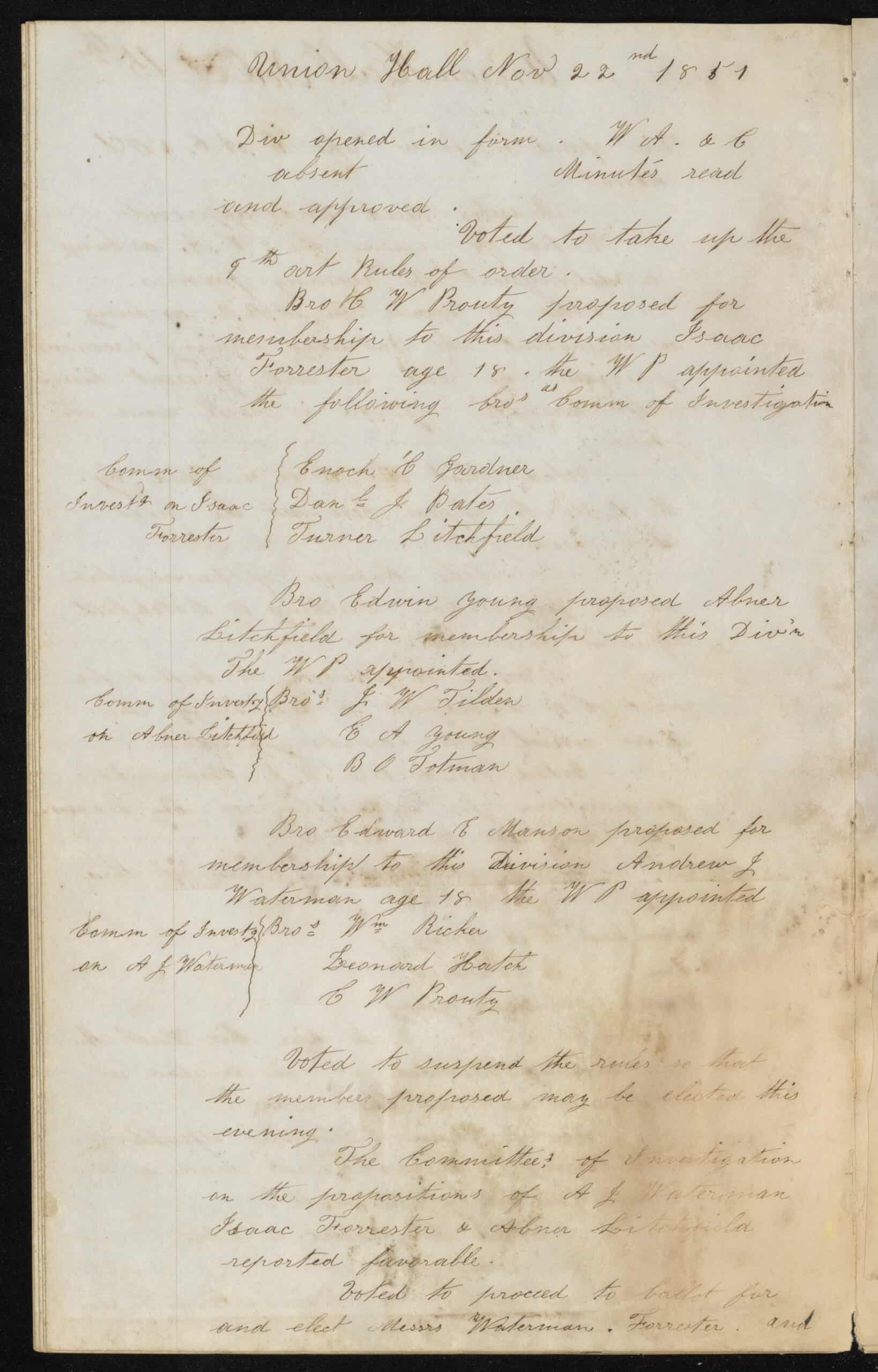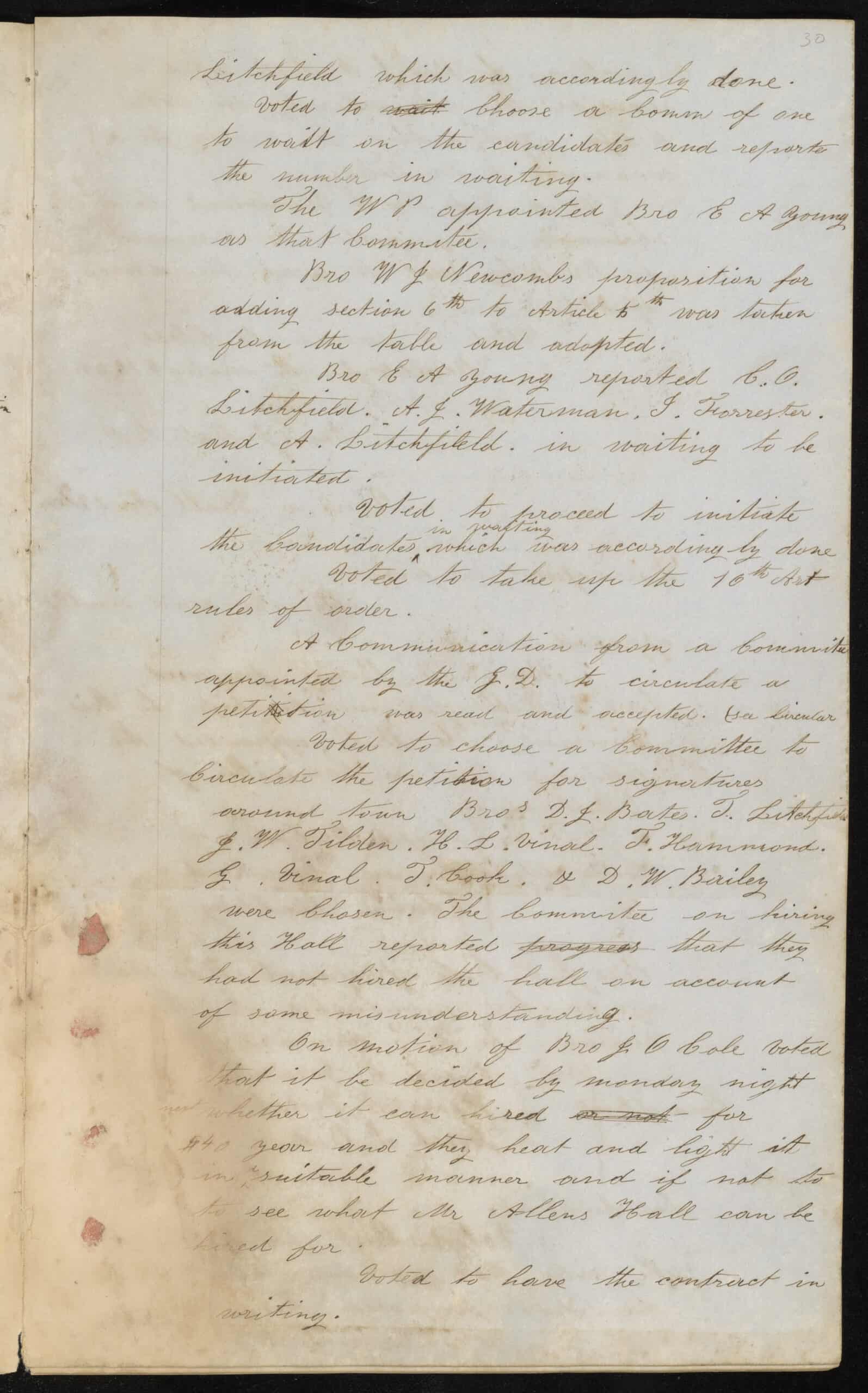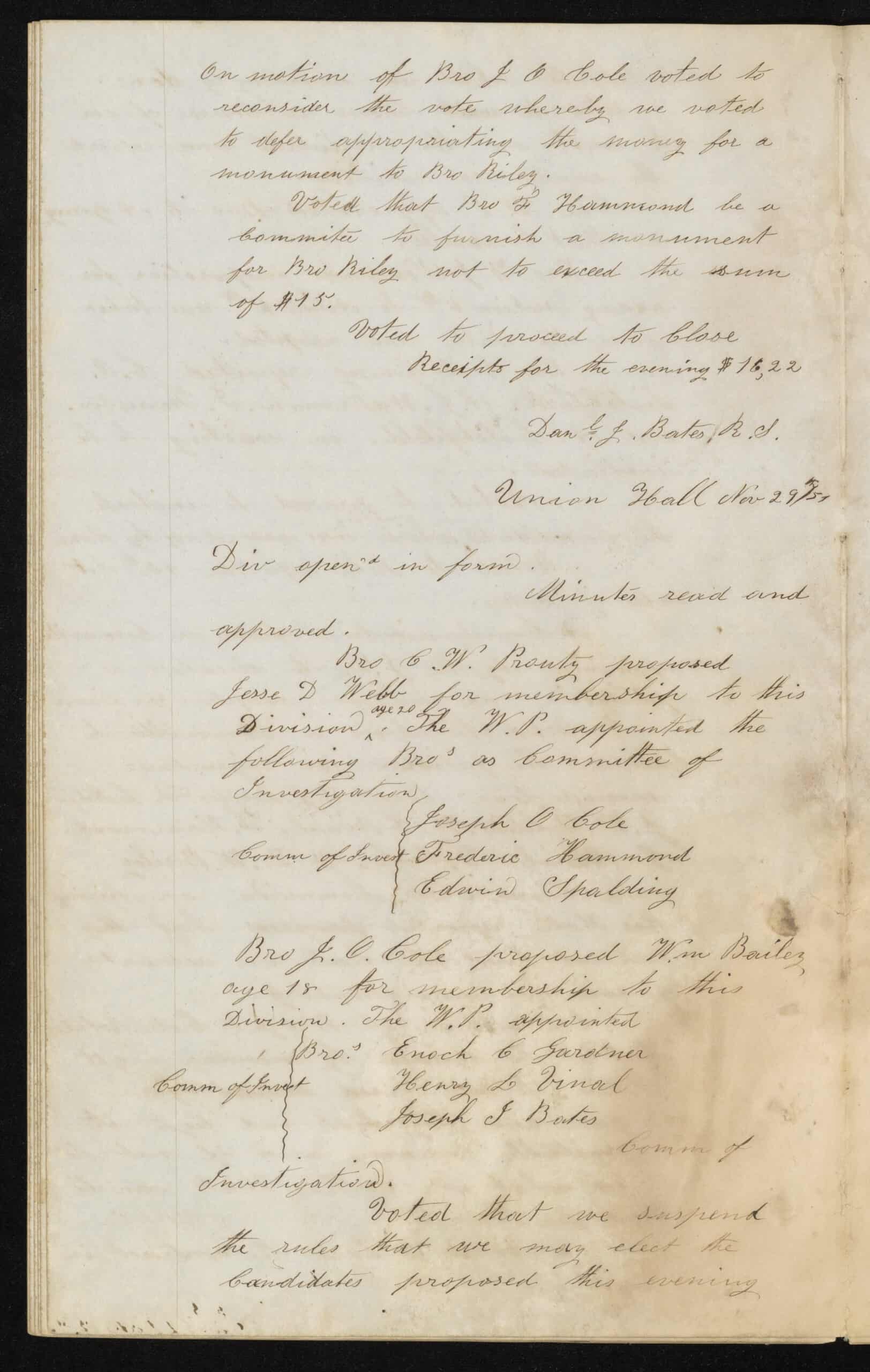COLLECTION HIGHLIGHT
Union Hall Temperance Records
Satuit Division – Sons of Temperance 1850-1855
Paper log book, cover missing
Dims: H 21 ½” x W 28 ½”
This journal contains the minutes of the Satuit Division of the Sons of Temperance meetings from 1850 -1855. The group met weekly in Union Hall which was on the second floor of the Union Schoolhouse located on First Parish Road between Carrie Litchfield Lane and Stockbridge Road. The Union Schoolhouse and Hall no longer exist.
These minutes provide tremendous insight into the Sons of Temperance organization, pulling open the curtain on what was a secret fraternity. From these minutes we can determine who were the members of the Sons in Scituate, how they carried out their mission, what issues they confronted, and the practical concerns of their operation.
The organization had its roots in the decades before the Civil War, a period of spiritual revivalism and social reform. Social reformers took on many of the perceived evils of American society including slavery, inequality of women, the poor quality of public education, inhumane treatment of the mentally ill, and alcoholism. There is no question that the citizens of Scituate were affected by and active in this period of reform, including temperance crusades.
The consumption of alcohol among adults had skyrocketed in the early nineteenth century and alcoholism had become a major problem across the United States by the 1820s. Many reformers of the period saw alcoholism as the biggest obstacle to maintaining order and morality in the young nation, seeing a direct correlation between alcohol and other forms of vice, and as a danger to family stability. In response, temperance reformers organized the American Temperance Society in 1826 to spread the movement nationally and within a decade had 5000 branches and over a million members. The movement was a great success. By the 1840s Americans drank half of what they had in the 1820s, and per capita consumption continued to decline over the next two decades.
In the 1840s the temperance movement created a new organizational format of fraternal societies. The largest of these was the Sons of Temperance founded in New York City in 1842. The Sons spread rapidly. By 1850 it had “divisions” in 23 states and close to 250,000 members, including Scituate’s own “Satuit Division” of the Sons of Temperance.
For a detailed discussion of the history of the movement and an analysis of this record book, see the essay “LOVE, PURITY, and FIDELITY: The Satuit Division of the Sons of Temperance” under Additional Information. Also provided is a sermon by Rev. Samuel Deane in 1817 to the Scituate Auxiliary for the Suppression of Intemperance and images of the original hand-written meeting minutes kept by the Auxiliary from 1817-1836.
The pages shown here are representative of their activities and practices:
- The minutes from October 5, 1850 show the formality of the organization and meeting process and include new members being sponsored and investigated, dues collection, and a topic proposed for discussion: “Is the present license law a righteous one”
- The November 22, 1851 meeting minutes chronicle the same process and discussion items include the $40 yearly rental fee for the Hall and an example of another benefit of membership: $15 was approved to purchase a grave monument for Brother Riley. Brother Riley was John O’Riley, who fell from a schooner and drowned, and was buried by the Sons in Union Cemetery – the first Catholic buried in Scituate.
The record book was digitized by the Northeast Document Conservation Center with Community Preservation Act funds generously granted by the town of Scituate.
Additional Information
Records of the Scituate Auxiliary for the Suppression of Intemperance vol. 3 – part 1
Records of the Scituate Auxiliary for the Suppression of Intemperance vol. 3 – part 2
Records of the Scituate Auxiliary for the Suppression of Intemperance vol. 3 – part 3
Records of the Scituate Auxiliary for the Suppression of Intemperance vol. 3 – part 4
LOVE, PURITY, and FIDELITY Satuit Division of the Sons of Temperance by James E. Glinski
Curriculum Connections
This Scituate Historical Society Collections Highlight connects with the following Massachusetts State Curriculum Frameworks:
History and Social Science | United States History
HSS.USI.T4.02 Social, political, and religious change
Using primary sources, research the reform movements in the United States in the early to mid-19th century, concentrating on one of the following and considering its connections to other aspects of reform:
a. The Abolitionist movement, the reasons individual men and women (e.g., Frederick Douglass, Abbey Kelley Foster, William Lloyd Garrison Angelina and Sarah Grimké, Charles Lennox Remond, Harriet Beecher Stowe, Sojourner Truth, Harriet Tubman, David Walker, Theodore Weld) fought for their cause, and the responses of southern and northern white men and women to abolitionism.
b. The women’s rights and suffrage movements, their connections with abolitionism, and the expansion of women’s educational opportunities (e.g., Susan B. Anthony, Margaret Fuller, Lucretia Mott, Elizabeth Cady Stanton, the 1848 Seneca Falls Convention, Mary Lyon and the founding of Mt. Holyoke Female Seminary, later Mt. Holyoke College).
c. Horace Mann’s campaign for free compulsory public education, increased literacy rates, and the growth of newspaper and magazine publishing.
d. The movement to provide supports for people with disabilities, such as the founding of schools for students with cognitive, hearing, or vision disabilities; and the establishment of asylums for people with mental illness.
e. The Transcendentalist movement (e.g., the writings of Ralph Waldo Emerson, Henry David Thoreau and Margaret Fuller, and the concepts of materialism, liberty, appreciation of the natural world, self-reliance, abolitionism, and civil disobedience).
